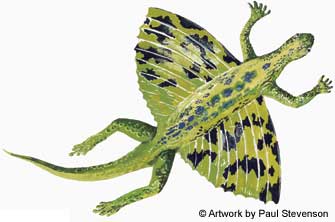
The fossils of Mendip
Silurian | Upper Devonian | Lower Carboniferous | Triassic | Lower to Middle Jurassic
Triassic fossils (251 to 200 million years ago)
Penarth Group
The terrestrial environment in which the greater part of the Triassic succession was formed was generally unfavourable for the preservation of fossils. An exception is the chance preservation of lizards, reptiles and dinosaurs in cave and fissure-infills in the Carboniferous Limestone, as demonstrated by the occurrence of the earliest flying vertebrate, Kuehneosaurus, at Emborough. However, the gradual advance of the sea across the Mendip region in the Late Triassic resulted in the deposition of the marine deposits of the Penarth Group, in which fossils are locally common. A bone bed is sometimes developed at the base of the Penarth Group (named the 'Rhaetic Bone Bed'), containing the bones and teeth of marine and freshwater fish and reptiles (including Ichthyosaurus and Plesiosaurus). The overlying sediments represent a variety of shallow marine, lagoonal and near-shore environments, and contain a low diversity fauna that includes the bivalves Modiolus, Protocardia, Rhaetavicula contorta and Chlamys valoniensis. A bone of the dinosaur Scelidosaurus in the succession near Wells shows that land was nearby.

- Home
- Overview maps
- Locality
areas
- Cheddar Gorge
- Charterhouse
- Blackdown
- Burrington Combe
- Shipham & Rowberrow
- Crook Peak & Axbridge
- Banwell to Churchill
- Priddy
- Harptree & Smitham Hill
- Draycott & Westbury-sub-Mendip
- Wookey Hole & Ebbor Gorge
- Wells
- Great Elm & Vallis Vale
- Mells & the Wadbury Valley
- The Vobster area
- The Whatley area
- Torr Works & Asham Wood
- Beacon Hill
- Stoke St Michael & Oakhill
- Holwell & Nunney
- Shepton Mallet & Maesbury
- Gurney Slade & Emborough
- The Nettlebridge valley
- Geology
- Minerals and mines
- Quarrying
- Caves and karst
- Biodiversity
- Detailed site information
- Acknowledgements
- External links
- Search
- Site map